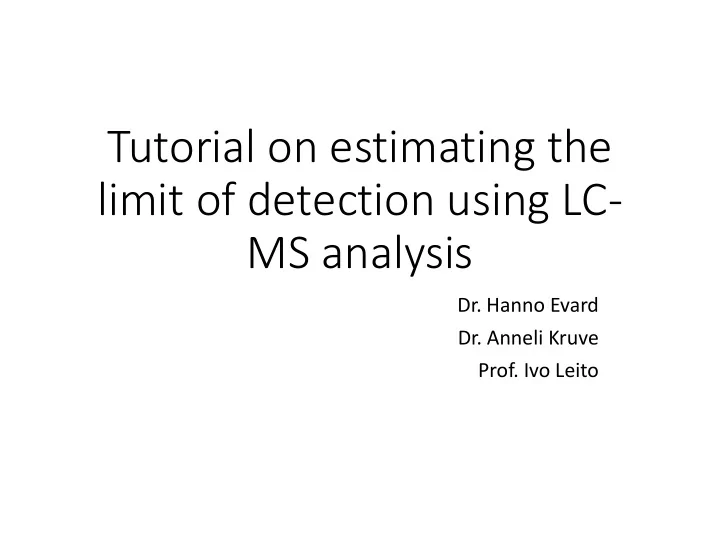

Tutorial on estimating the limit of detection using LC- MS analysis Dr. Hanno Evard Dr. Anneli Kruve Prof. Ivo Leito
About the articles • Two part tutorial • Theoretical review of Limit of Detection (LoD) • Practical aspects of estimating LoD • Focusing on estimation methods suggested by different organizations • Focusing on liquid chromatography mass spectrometry (LC- MS) • Analysis methods are not equal 2
Limit of Detection Limit of detection (LoD) – smallest amount or concentration of analyte in the test sample that can be reliably distinguished from zero • Answers two separate questions: • Is the analyte detected in the sample? • How low concentrations can this analytical method detect? 3
CC α and CC β LoD • The general LoD definition is • False positive and false negative ambiguous results in definition • Many different approaches to • Estimation can be statistically estimate LoD complex • Different standards and • LoD equal to CC β guidelines suggest different approaches • Approaches make assumptions and simplifications β probability α probability LoD is not appropriate for critical decisions (detected or not?) 4
Differences in approaches LoD (mg/kg) 0 0,0025 0,005 Description Guideline 1 LoD = I(blank) + 3 × s(blank) AOAC, Eurachem 2 LoD = I(blank) + 4.65 × s(fortified) Eurachem 3 S/N ≥ 3 ICH 4 “Cut-off” approach Eurachem, NordVal 5 Visual evaluation ICH 6 LoD = 3.3 × s(blank) / Slope ICH 7 LoD = 3.3 × s(intercept) / Slope ICH 8 LoD = 3.3 × s(residuals) / Slope ICH Meropenem / Agilent 5
Goals of the experimental work 1. Compare LoD to CC β 2. Compare estimates of different approaches 3. Study experimental design for LoD estimation 4. Study subjectivity of relevant tests 5. Change of LoD between days 6. Make practical suggestion for estimating LoD for MS methods 6
LC-ESI/MS/MS • Different methods give • CC β significantly different similar results from LoD in some cases 0,004 0,05 0,04 0,003 LoD (mg/kg) CCβ (mg/kg) 0,03 0,002 0,02 0,001 0,01 0 0 CCβ from homoscedastic data Meropenem (with ESI) Meropenem (with 3R) CCβ from heteroscedastic data Spiroxamine (with ESI) 3.3*Sy.x/b 7
Simulations, experimental design • Calibration points below LoD used for estimation • Simulations in R with random number generator • 1000 calibration lines generated and LoD estimated • Standard deviation (stdev) of blank samples is 100 and slope is 5 Average Average CCα = 32.9 & CCβ = 65.8 Stdev of slope (LoD, stdev of residuals) (LoD, stdev of intercept) 1 C = (0, 75, 100, 125, 150, 175, 200) 0.60 65 (±22) 12.8 (±1.6) 2 C = (0, 35, 60, 85, 110, 135, 160) 0.72 63 (±23) 12.8 (±2.0) 3 C = (0, 5, 25, 50, 75, 100, 125) 0.83 65 (±24) 13.0 (±2.3) 4 C = (0, 5, 10, 15, 20, 25, 30) 3.75 286 (±7862) 38.1 (±1068.2) 8
Between-days LoD and between- labs LoD ANOVA p Spiroxamine 0.62 Imazalil 0.64 • Systematic approach or solution has Triazophos 0.21 Propamocarb 0.42 not been offered Thiabendazol 0.70 • Depends on analytical method Carbendazim 0.60 ������ Within-day LoD Between-days LoD Between-labs LoD 1. LoD is critical Interpretation of 2. Variance of LoD Suitable Not suitable results between days is large Characterization of Not appropriate For comparing analytical Suitable analysis method (only approximately) methods 9
10
Further issues to consider • Fragmentation and identification • Tolerance interval • Bayesian statistics • LoD estimation with different analytical methods • Issues with Limit of Quantitation • Education of metrology in chemistry 11
Thank you! 12
Recommend
More recommend